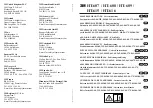
The sensing range is adjusted by pressing the teach-in button. Do not operate the teach-in
button using sharp objects. We recommend placing the switching state in the object, e. g.,
see graphic E. Once the sensing range has been adjusted, the object is removed from the
path of the beam, which causes the background to be suppressed and the switching out‐
put to change (see graphic C).
Please refer to the enclosed operating instructions for the IO-Link photoelectric sensor for
information about adjusting the IO-Link sensing range.
The sensor is adjusted and ready for operation. Refer to graphics C and E to check the
function. If the switching output fails to behave in accordance with graphic C, check appli‐
cation conditions. See section Fault diagnosis.
4
WT teach modes
Teach-in mode
for objects /
Teach-in mode
for objects
Teach-in time /
Teach-in time
Alignment /
Alignment
LED indicator /
LED indicator
Results /
Results
Single teach-in
pushbutton /
Single teach-in
pushbutton
Approx. 1.0 s /
Approx. 1.0 s
Sensor to
object /
Sensor to object
Ö
Sensing range is
adjusted accord‐
ing to object /
Sensing range is
adjusted accord‐
ing to object
ET: Connect pin 5
or gray wire to UV
for > 2 to < 4 s
(). /
ET: Connect pin 5
or gray wire to UV
for > 2 to < 4 s ().
> 2 s
Sensor to
object /
Sensor to object
Ö
Sensing range is
adjusted accord‐
ing to object /
Sensing range is
adjusted accord‐
ing to object
5
Additional functions
Test input: The WTT12L sensor features a test input ("TI" or "Test" on the connection
diagram [B]), which can be used to switch the sender off and therefore check that the
sensor is functioning correctly: If female cable connectors with LED indicators are used,
you must ensure that the TI is assigned accordingly.
There must be an object in the path of the beam (light reception); activate the test input
(see the connection diagram [B], TI 24 V). The send LED is shut down or no object being
detected is simulated. Refer to Graphics C to check the function. If the switching output
fails to behave in accordance with Graphic C, check application conditions. See section
Fault diagnosis.
The sensor can be used in standard I/O mode (SIO) or IO-Link mode (IOL). All automa‐
tion functions and other parameter settings are effective in IO-Link mode and in stan‐
dard I/O mode (exception: time stamp). Output of binary switching signals during stan‐
dard I/O operation via pin 4/black wire or via pin 5/gray wire.
Information on the IO-Link functions can be found in the enclosed IO-Link photoelectric
sensors operating instructions or downloaded from www.sick.com under the device
order number.
6
Troubleshooting
The Troubleshooting table indicates measures to be taken if the sensor stops working.
WT TEACH MODES
4
8018110.ZM26 | SICK
Subject to change without notice
7









































